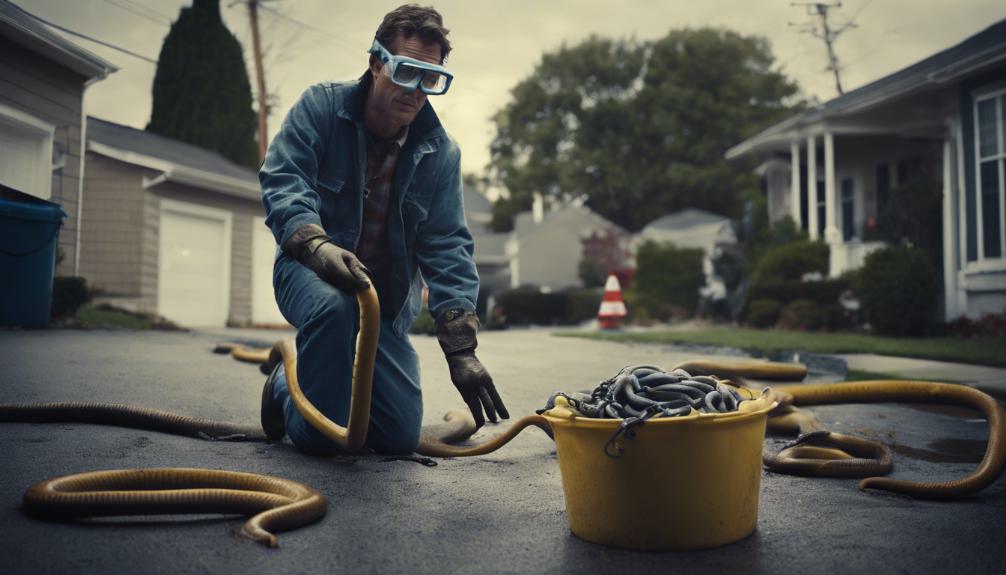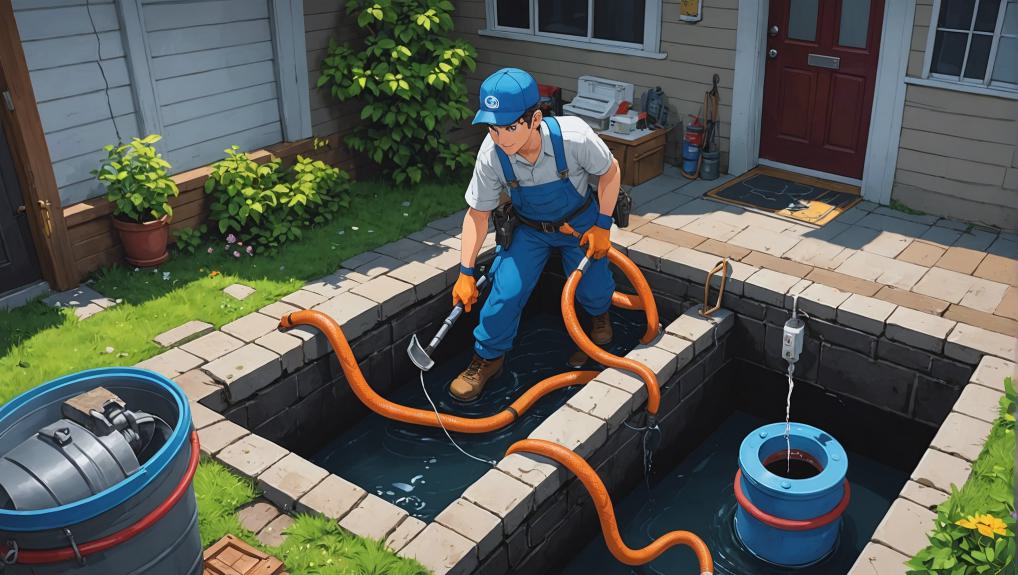When unclogging a main sewer line at home, prioritize safety. Don gloves, goggles, and a mask. Lay down protection like plastic tarps. Ventilate the area and clean thoroughly when finished. For legalities, rules can differ, so consult local regulations. To start, locate the blockage, clear it, and check the drain. Use methods like video inspection or snaking. For eco-friendly options, try baking soda and vinegar. Unblocking a main sewer line tackles common issues efficiently. Precise guidance guarantees success with each step you take to tackle this task.
Identify the blockage location using video inspections or snaking techniques. Clear the clog with eco-friendly methods like baking soda and vinegar. Test the drain to ensure proper flow after unclogging. Wear protective gear such as gloves, goggles, and masks. Restore the main sewer line's functionality by breaking apart or removing the blockage.
Main Sewer Unclogging: What Safety Precautions Required?

When unclogging a main sewer line, it’s essential to guarantee proper ventilation, wear protective gear like gloves and goggles, and lay down surface protection to prevent any mess.
Additionally, remember to disinfect the area thoroughly after completing the unclogging process to maintain a safe environment for yourself and others.
Taking these safety precautions will help you tackle the task effectively and without any harm to your health.
Proper Ventilation
To ensure your safety while unclogging the main sewer line, prioritize proper ventilation by opening windows, doors, or using a fan to circulate air and reduce the risk of inhaling toxic fumes.
Essential ventilation is important when working on sewer lines to prevent exposure to harmful gases like methane and hydrogen sulfide, which can be present in sewage systems. By ensuring good airflow in the area, you create a safer environment for yourself and others.
Toxic fumes can be harmful if inhaled, leading to dizziness, nausea, or even more severe health issues. Thus, make it a priority to keep the space well-ventilated throughout the unclogging process to minimize any potential risks associated with working on the main sewer line.
Protective Gear
Protect yourself from harmful substances and fumes by wearing appropriate protective gear like gloves, goggles, and a mask when unclogging the main sewer line. Here’s what you need to stay safe:
- Gloves: Protect your hands from coming into direct contact with debris and chemicals.
- Goggles: Shield your eyes from splashes and particles that may cause irritation or harm.
- Mask: Prevent inhalation of noxious fumes and airborne particles that could be hazardous to your health.
Surface Protection
After ensuring you have the necessary protective gear, the next step in safely unclogging the main sewer line is to cover nearby surfaces to prevent any potential damage. Lay down plastic tarps, old towels, or newspapers on the floor around the access point to catch any spills or splashes that may occur during the unclogging process.
Additionally, consider using duct tape to secure the protective covering in place and prevent it from shifting. By taking this precaution, you can avoid costly damage to your floors, walls, or belongings. Remember, it’s better to be safe than sorry when dealing with potentially messy tasks like unclogging a main sewer line.
Disinfection
When disinfecting the area after unclogging the main sewer line, make sure to conduct thorough cleaning with bleach to eliminate bacteria and maintain a sanitary environment.
Here are some safety precautions required:
- Wear Protective Gear: Put on gloves, goggles, and a mask to protect yourself from harmful fumes and bacteria.
- Ventilation: Guarantee proper ventilation in the area by opening windows or using fans to avoid inhaling strong cleaning fumes.
- Follow Instructions: Read and abide by the manufacturer’s instructions on the cleaning products carefully to ensure safe and effective use.
Legal Regulations for Unclogging Main Sewer Lines
Legal regulations governing the unclogging of main sewer lines vary depending on the jurisdiction in which the property is located. In some areas, homeowners are responsible for maintaining and unclogging the main sewer line that runs from their property to the municipal sewer system. However, in other jurisdictions, this responsibility may fall under the jurisdiction of homeowner associations (HOAs) or even local government authorities.
For instance, in condominium complexes, HOAs often oversee the maintenance of common area sewer lines, while individual unit owners are typically responsible for the upkeep of the sewer lines within their units. Liability for damages resulting from sewer line issues can also differ based on the cause of the problem, with some cases requiring legal consultation to determine responsibility.
It’s important to be aware of these legal regulations to ensure compliance and avoid any potential legal issues. If in doubt, contacting the appropriate local authorities or seeking legal advice can help clarify your responsibilities when it comes to unclogging main sewer lines.
step by step guide to unclog main sewer line
To effectively unclog a main sewer line, begin by gathering the necessary tools and protective gear for the task. Once you have everything ready, follow these steps:
- Step 1: Identify the Problem Area
- Use a sewer camera or auger to locate the blockage in the main sewer line.
- Step 2: Clear the Blockage
- Use a sewer snake or hydro jet to break up and remove the clog from the sewer line.
- Step 3: Test the Drain
- Run water through the drain to make certain the blockage is completely removed and the water is flowing freely.
Remember to wear gloves and eye protection when handling any tools or coming into contact with sewage. By following these steps, you can successfully unclog your main sewer line and restore proper drainage in your home.
Locating Main Sewer Line Blockage: Best Methods
Using advanced techniques such as video inspections, snaking, hydro-jetting, and trenchless pipe lining can effectively pinpoint and address blockages in the main sewer line. Video inspections are useful for locating blockages and determining their severity. Snaking and hydro-jetting are effective methods for removing roots, grease, and debris causing the clog. Trenchless pipe lining offers a non-invasive solution by pulling a new pipe through the old one, reducing disruption and costs. These professional methods guarantee that blockages are efficiently identified and resolved.
| Method | Description |
|---|---|
| Video Inspections | Utilizes a camera to identify blockage location and severity, aiding in targeted solutions. |
| Snaking | Involves using a flexible auger to break apart and remove clogs such as roots or solid obstructions. |
| Hydro-Jetting | High-pressure water is blasted through the pipes to clear out blockages like grease or sludge. |
| Trenchless Pipe Lining | A new pipe is installed inside the existing one, repairing cracks or leaks without excavation. |
Eco-Friendly Ways to Unclog Main Sewer Line

For a more environmentally conscious approach to unclogging your main sewer line, consider utilizing eco-friendly methods such as baking soda and vinegar or homemade drain cleaners. These methods not only help clear the blockage but also protect your pipes and the environment. Here are some eco-friendly ways to unclog your main sewer line:
- Baking Soda and Vinegar: Create a fizzy reaction by pouring baking soda followed by vinegar down the drain. This natural reaction can help break down clogs without harsh chemicals.
- Plungers: A simple yet effective tool for dislodging minor clogs in your main sewer line. Use a plunger with a good seal for better results.
- Homemade Drain Cleaners: Mix ingredients like baking soda, vinegar, and hot water to create a homemade drain cleaner. This solution can help dissolve blockages gently without harming your pipes.
Frequently Asked Questions
Can I Use Chemical Drain Cleaners for Main Sewer Line Clogs?
You can use chemical drain cleaners for main sewer line clogs, but be cautious. They may not always be effective for severe blockages and can harm pipes. Consider consulting a professional for stubborn clogs.
How Can Tree Roots Be Prevented From Clogging the Sewer Line?
To prevent tree roots clogging your sewer line, plant trees far from the sewer, use root barriers, and opt for shrubs instead of deep-rooted trees near pipes. Regularly maintain your sewer line to catch issues early.
Are DIY Methods for Unclogging Sewer Lines Effective?
DIY methods for unclogging sewer lines can be effective for minor blockages. Using tools like augers or drain snakes can help clear simple clogs. However, for severe issues, it’s best to consult a professional plumber.
Is It Possible to Prevent Future Main Sewer Line Clogs?
You can prevent future main sewer line clogs by being mindful of what goes down your drains, scheduling regular professional inspections, avoiding flushing non-flushable items, and considering preventive measures like drain strainers.
